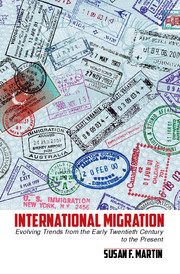Book contents
- Frontmatter
- Contents
- Foreword
- Acknowledgments
- List of Acronyms
- Introduction
- 1 Early Roots
- 2 “The Problem of Refugees”
- 3 Labor Mobility
- 4 Orderly and Humane Migration Management
- 5 Trafficking in Persons
- 6 Migration and International Security
- 7 Migration, the Environment, and Climate Change*
- 8 Migration and Development
- 9 Towards the Future
- Bibliography
- Index
- References
8 - Migration and Development
Published online by Cambridge University Press: 05 August 2014
- Frontmatter
- Contents
- Foreword
- Acknowledgments
- List of Acronyms
- Introduction
- 1 Early Roots
- 2 “The Problem of Refugees”
- 3 Labor Mobility
- 4 Orderly and Humane Migration Management
- 5 Trafficking in Persons
- 6 Migration and International Security
- 7 Migration, the Environment, and Climate Change*
- 8 Migration and Development
- 9 Towards the Future
- Bibliography
- Index
- References
Summary
The issue of migration and development is now firmly on the international agenda. As the previous chapters have indicated, the concept is not new. During the past century, however, the concept of development has changed. Initially, development was viewed in primarily economic terms – what would augment economic growth in poor countries. More recently, development has been conceived in broader terms. The UNDP argues, for example, that development “is about much more than the rise or fall of national incomes. It is about creating an environment in which people can develop their full potential and lead productive, creative lives in accord with their needs and interests.” The Millennium Development Goals adopted at the Millennium Summit of world leaders in 2000 are based on this understanding of development. Governments committed to make progress in eight areas: ending poverty and hunger, achieving universal education, reducing gender inequality, improving child and maternal health, combating HIV/AIDS, ensuring environmental sustainability, and developing a global partnership for development.
In the periods after both World Wars, the interconnection between reconstruction and resettlement of displaced persons received considerable attention. With the end of the Cold War, it is not surprising that attention turned once more to role that migration plays in development and vice versa. Almost fifteen years ago, the International Conference on Population and Development (ICPD) in Cairo produced a twenty-year plan of action that included ways in which developing countries could accelerate development to make emigration unnecessary. The cooperation of industrial countries was required via “financial assistance, reassessment of commercial and tariff relations, increased access to world markets and stepped-up efforts…to create a domestic framework for sustainable economic growth with an emphasis on job creation” (UN 1995: 68).
- Type
- Chapter
- Information
- International MigrationEvolving Trends from the Early Twentieth Century to the Present, pp. 235 - 269Publisher: Cambridge University PressPrint publication year: 2014

